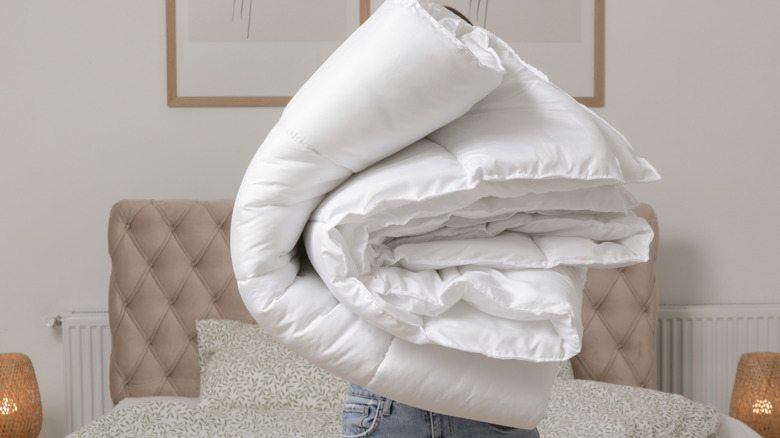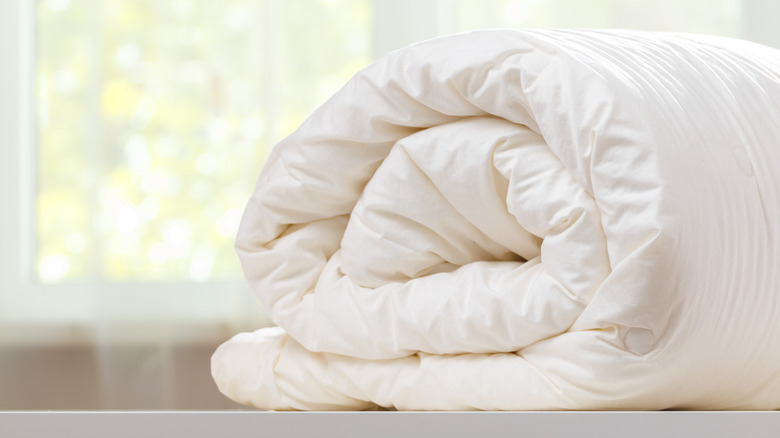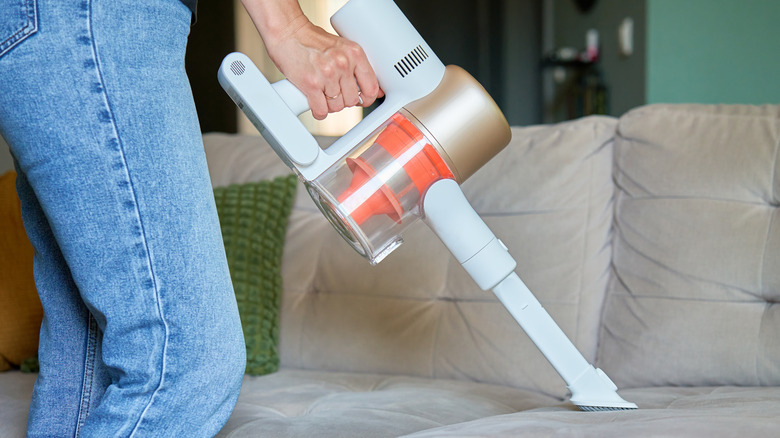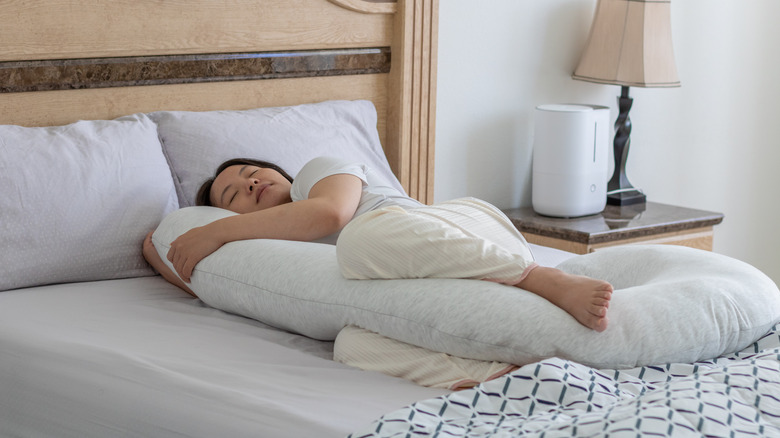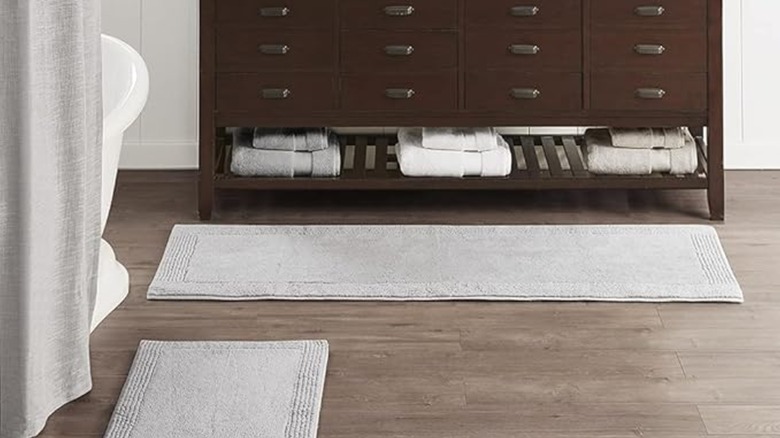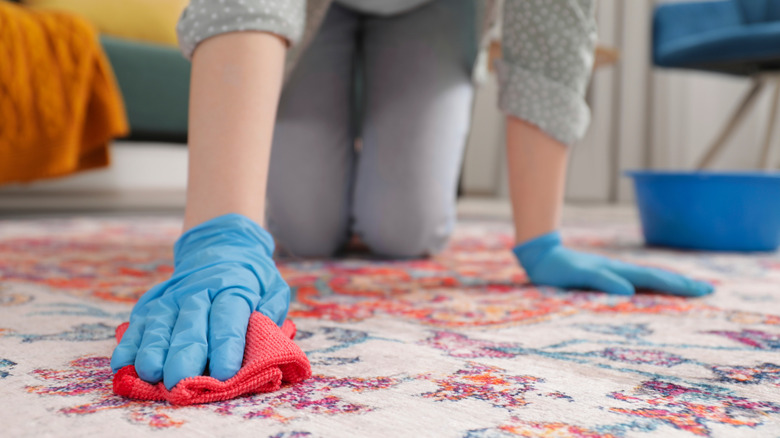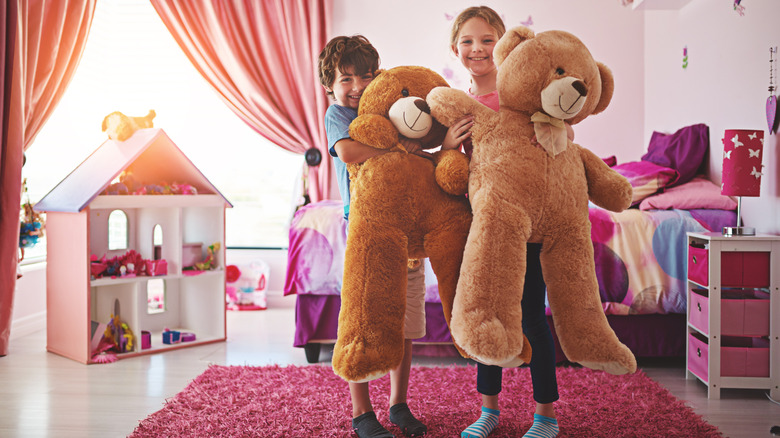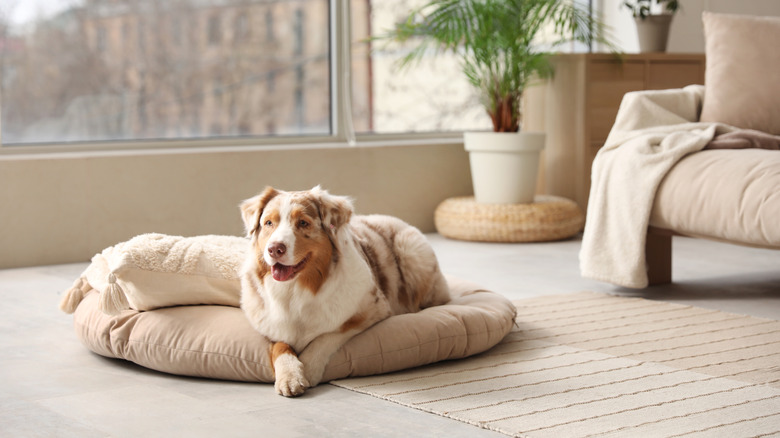How To Clean Your Comforter And These 7 Items That Are Too Big For Your Washer
We may receive a commission on purchases made from links.
Washing machines are certainly a modern convenience. They make doing a load of clothing, towels, sheets, and so many other laundry items a breeze. However, these appliances do not have an unlimited capacity, and certain items are simply too big too was in them. While some won't fit, period, cramming other items, such as a bulky comforter or an oversized dog bed, would result in overloading the machine. This is one way in which you can destroy a washer without even realizing it, so you definitely don't want to do that.
So, just how are you supposed to clean oversized comforters, body pillows, or area rugs if they're too large to fit in your washer? Unfortunately, there is no blanket answer (pun intended) to this question. The best way can vary depending on the type of item you need to clean and how it is constructed. Ahead, we'll share some tips that should help you clean your comforter and a variety of other oversized items that are too big to fit properly in a washing machine.
Wash comforters in the bathtub
If you have a small washing machine — or a really puffy comforter — it may be impossible to clean it like the rest of your linens. Fortunately, there are other ways to wash a comforter when it is too big for your washer. While you could bring it to a laundromat or a dry cleaner, your bathtub can also become your new best friend for cleaning oversized items.
To clean your comforter in the bathtub, start by stopping the drain and filling it about halfway with warm water (or whatever the care tag recommends). Then add the recommended amount of laundry detergent. Use a large nylon or silicone spoon to stir the water and mix in the detergent before carefully placing your comforter into the tub. Allow the comforter to sit in the water for a few minutes while you agitate it using the spoon or another long-handled device. This step will help loosen and remove dirt and grime. After agitating, you may let the comforter soak for up to an hour to give it a deeper cleaning.
Once the comforter is clean, you'll need to rinse it. This may be a lengthy process, since it will likely be holding a lot of detergent. Start by draining the sudsy water from the tub and wringing out as much excess water and soap as possible. Then, refill the tub with clean water and repeat the steps above (minus the detergent) until there are no more suds. Once fully rinsed, you'll need to move the comforter to be dried. Keep in mind that it will be very heavy from all of the water it is holding, so you might want to ask another person to help you carry it. Even if you squeeze excess water out, it will likely also drip, so you might want to move it in a large trash bag or bucket. If your dryer is large enough, you can dry the comforter in it. Otherwise, consider laying it out in the sun over a patio chair or on a heavy-duty drying rack. Pick a time to wash your comforter when there is no rain in the immediate forecast, and be prepared for it to take multiple days for it to fully dry.
The best way to clean sofa cushions will depend on the cover material
While some sofa cushions have removable covers that can make them easier to wash, others do not. This means that you'll need to hand-wash the cushions anytime you want to freshen them up. While this won't be an overly challenging task, the specific cleaning supplies and procedures you'll need will vary depending on the type of material your cushion's covers are made of, as well as their filling. While there are some general recommendations for different types of materials, you should also look for more specific guidelines from the manufacturer, which should be found on the tag on one of the cushions. You might see a letter code — W, S, WS, or X. W means you should use water-based cleaners; S indicates that solvent-based cleaners; WS means either water- or solvent-based cleaners are acceptable; X means that you shouldn't use any cleaning products and should only vacuum the cushion.
If you're cleaning cushions that are compatible with water- or solvent-based cleaners, you will still want to start by vacuuming the surface with a gentle brush attachment to remove dust and loose debris. This will make it easier to clean the cushion and will help make sure you don't inadvertently press the dirt deeper into the fabric. Regardless of the material you're cleaning, you'll also want to be careful to avoid using too much of your cleaning solution or water. You don't want too much moisture to penetrate into the cushion and get the padding wet, or for it to damage the surface material.
Spot clean or hand wash oversized pillows
Body pillows and other oversized pillows in your home may simply be too large to fit in the washing machine. While this might sound less than ideal as you think about all the sweat, dirt, and dead skin cells that have accumulated on the pillow over time, the good news is that there are some washer-free tricks to help you clean and freshen pillows. You can hand-wash pillows that are too large to fit in your washing machine in the bathtub. This is also a good approach to follow when cleaning even standard-sized latex or memory foam pillows, as they can get damaged in a washer.
Begin by filling a clean bathtub about halfway with water (use cold water for foam pillows to avoid damaging the material). Add mild detergent and stir until everything is all mixed together. Add your body pillow to the tub, let it soak for a few minutes, and use your hands to agitate it in the water to help release any gunk. After cleaning the pillow, drain the water from the bathtub. Then, fill it back up with clean water to rinse out the soap. Continue draining and refilling with clean water until all the soap has been rinsed away. Choose a flat area to lay the pillow out to dry. A sunny outdoor spot is ideal, but if one is not available, you can also place a fan close by to help speed up the drying process. Before leaving the pillow to dry, be sure to reshape it if necessary. You can flip the pillow to help it dry faster and more evenly, but don't leave it in the direct sun for more than two hours to avoid discoloration.
Hand wash bath mats that won't fit in the washer
If you're fortunate enough to have a spacious bathroom, then you might also have some very large bath mats. These may be too big to fit in your washer, so you'll need to find an alternative method to get them clean. Oversized mats are another item that can be cleaned in the bathtub with relative ease. Before you drop them into a tub filled with water and some mild detergent, however, you'll want to complete a few additional steps. Bath mats often collect dirt and dust, so you don't make the water in the tub overly dirty. One tip for cleaning your bath mat at home is to start by shaking out the mat to remove as much dirt as possible. If there are any stains on your mat, you should also pre-treat them with a stain remover, such as the Shout Active Enzyme Laundry Stain Remover, before hand-washing them.
After letting the stain remover sit in for a few minutes (if necessary), submerge the mat in the solution of water and detergent in the tub. Agitate it well, and let it soak for up to 20 minutes to help loosen and remove as much gunk as possible. Follow the steps outlined above for rinsing a comforter or pillows by draining the water, filling the tub with clean water, and repeating as necessary to get rid of all the suds. Finally, hang the rug on a drying rack — such as the Honey-Can-Do DRY Collapsible Steel Drying Rack — or lay it flat to dry (check the manufacturer's recommendations). If laying it flat to dry, be sure to place towels under it and to flip it over the following day.
Spot-cleaning is often all that is necessary for a sleeping bag
Sleeping bags aren't designed to be given a full washing after every use. Heavy-duty cleaning and submerging them in water isn't good for their loft and can damage the material. In many cases, your bag may only need a little spot-cleaning, so start with that before deciding something more thorough is necessary. To spot-clean a sleeping bag, you can make a gentle cleaning solution using water and a non-detergent soap (like the Dr. Bronner's Pure-Castile Magic Soap). Dip a toothbrush or a soft-bristled brush (such as one of the Selaurel Laundry Scrub Brushes) in the cleaning solution and gently rub it over the affected areas on the outer shell.
When a deeper clean is necessary, you can hand-wash the sleeping bag in your bathtub following the steps outlined above for comforters. However, be sure to check the manufacturer's care instructions. Some may recommend a special type of detergent, such as the Nikwax Tech Wash, which can help restore the water-repellent properties of the sleeping bag. While hand-washing your sleeping bag is possible, due to the extended drying time (and how heavy the sleeping bag will be when it is still wet), you might decide that a trip to the laundromat is warranted. Most sleeping bags should not be cleaned in top-loading machines with agitators, which is another reason a laundromat is preferred over many home setups, even if the sleeping bag isn't too big to fit.
Consult the care tag before attempting to wash a rug at home
If you're looking for tips to keep your rugs in pristine condition, it is important to understand that the best methods to use will vary depending on the type of rug you're talking about. The most important first step will be to consult the manufacturer's care instructions. If there is not a care tag on the back of the rug (or if you cut it off), you can check the company's website for more specific instructions.
If you have a rug that is machine washable, but that won't fit in your laundry machine, then you can hand-wash it in the tub following the steps outlined above for cleaning a comforter. However, it is important to note that many types of rugs are not designed to be fully submerged, so in addition to not being good candidates for your washing machine (even if they would fit), they also shouldn't be hand-washed in the bathtub as you would to clean other bulky items. For example, rugs made from natural fibers, many handmade products, or those that have a braided design will typically require spot-cleaning only.
After vacuuming any loose debris (and shaking the rug out to remove anything else that will drop off of it), you can use a soft-bristled brush and a mixture of warm, soapy water to blot out any stains. For heavier stains, you might consider reaching out to a professional cleaning company. If the care label for your rug says "dry clean only," then it is important to follow this advice. Attempting to clean the rug using another method could result in damage to the backing or the overall construction.
Wash large stuffed animals by hand with a mild detergent
Knowing how to clean your kids' stuffed animals properly is crucial — especially because you don't want to ruin these treasured toys. While many of their stuffies may be safe to put in the washing machine, some oversized "friends" simply won't fit. For these (and any others that are not machine-washable), hand-washing will be the best approach to take. Fill the bathtub with water and a little mild detergent. After moving the water around to distribute the detergent, you can put the large stuffed animal in the tub.
Gently move the stuffie back and forth through the water to help release any dirt or other gunk that is stuck on its fur. Drain the tub and squeeze out the excess soapy water from the toy. Fill the tub with clean water to rinse. Repeat draining and filling up the tub with fresh water until all the soap is gone.
Once thoroughly rinsed, put the stuffed animal outside to let it dry. Keep in mind that large stuffed animals will take a long time to dry. Because of this, you might want to save giving them a full bath for when they're really dirty and grimy. For lighter cleaning needs, consider adding a little baking soda to the fur to deal with unpleasant odors. After letting the powder sit for a few hours or overnight, vacuum up the excess. A steam cleaner (if tested on a hidden spot on the stuffed animal first) can also be used when cleaning these large toys, if tolerable.
Use the bathtub when pet beds need a good cleaning
Keeping your pet happy and healthy is important. One way to do this is to make sure they have a clean spot to sleep at night — and for all those daily naps. Before attempting to clean your pet's bed, it is imperative to read the manufacturer's care label. While some are machine-washable, others may have removable covers that can be cleaned in a machine (or submerged in water). If your pet's bed is washable, it is likely too big to fit in your washing machine. In these instances, you'll want to start by pre-treating any stains. Then, you can hand-wash the bed in the bathtub using a pet-safe detergent, such as the Pet Parents PetTergent Enzymatic Laundry Detergent. Follow the same steps outlined above to agitate the bed to loosen debris, and then to thoroughly rinse out all of the soapy residue.
Beds with removable covers can greatly simplify the cleaning process. Often, you just need to remove the cover and wash it in the machine (or by hand). Either of these are much simpler than hand-washing the entire bed. If your pet's bed does not have a cover that zips off, you might want to consider getting creative with some old pillowcases. If you use pillowcases to make a second cover your dog or cat's bed, then you can simply remove it and wash it as needed. For larger beds, you could consider making a removable cover by sewing a pillowcase-like shape out of an old sheet.
